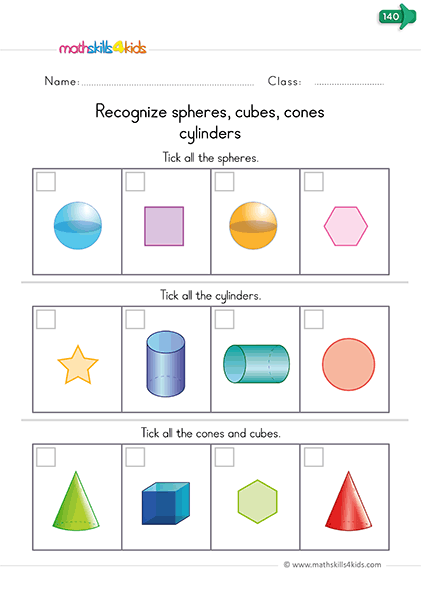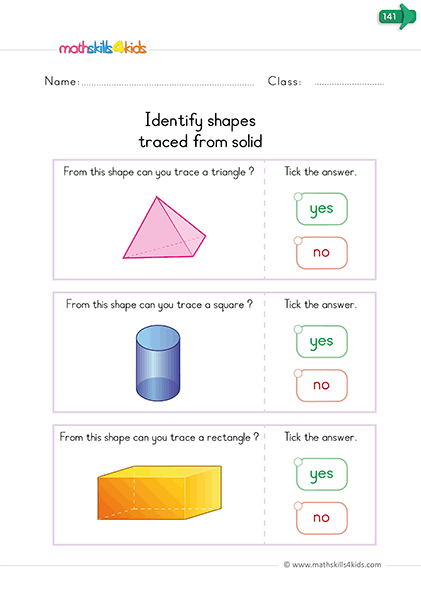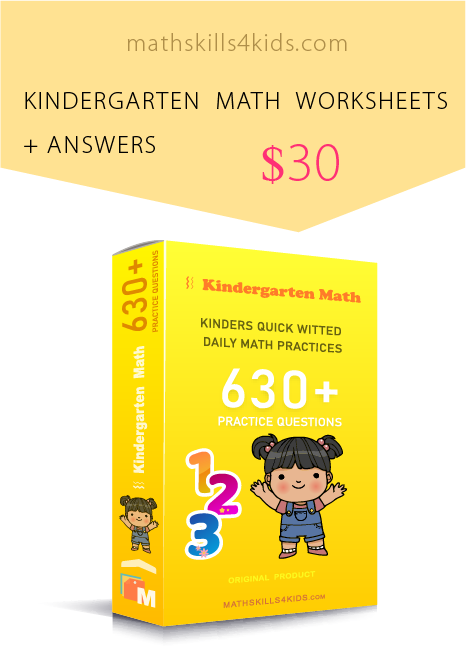3D Shapes worksheets and activities for kindergarten
Hi everyone! Welcome to another fun and educational kindergarten resource from MathSkills4kids about solid shapes worksheets and activities. Today we invite all parents and teachers to explore and use our 3D Shapes worksheets and activities to teach kindergarteners about the names and properties of different 3D shapes.
-
3D shapes differ from 2D shapes because they have depth and can be seen from different angles. They are also called solid shapes because they take up space and can be held in your hands.
However, these solid shapes printable worksheets and activities will help them visualize what 3D shapes look like in the world around them.
Are you ready to explore the wonderful world of 3D shapes? Let's get started!
What are 3D Shapes? Learn the names and properties of different 3D shapes with fun examples and pictures.
To fully understand what 3D shapes are, we must learn their names and properties. In this light, we will design different 3D shapes with fun examples and pictures for kids to kick-start learning about solid shapes excitingly.
Here are some examples:
- Cube: A cube has six square faces that are all the same size. It looks like a dice or a Rubik's cube. It has 12 edges and 8 vertices (corners).
- Sphere: A sphere has no faces, edges, or vertices. It is perfectly round and smooth. It looks like a ball or a planet.
- Cylinder: A cylinder has two circular faces parallel to each other. It also has one curved face that connects them. It looks like a can or a roll of paper towels.
- Cone: A cone has one circular face and one curved face that comes to a point. It looks like an ice cream cone or a party hat.
- Pyramid: A pyramid has one polygon (a shape with many sides) as its base and triangular
faces that meet at a point. It looks like the pyramids in Egypt or a tent.
There are many more 3D shapes, but these are some of the most common ones. Each 3D shape has its own properties, such as how many faces, edges, and vertices it has.
These properties will help us identify and describe 3D shapes easily. For example, we can say that a cube has six faces, 12 edges, and eight vertices, while a sphere has none of these.
-
BROWSE THE WEBSITE
-
DOWNLOAD FREE WORKSHEETS
-
-
K- MATH TOPICS
- Learn to count up to 3
- Counting from 1 to 5
- Count up to 10
- Learn to count up to 20
- Counting to 100
- Skip counting
- Measurement
- Sum and difference
- Comparison
- Patterns
- Addition up to 5
- Addition up to 10
- Subtraction up to 5
- Subtraction up to 10
- 2D shapes
- Introduction to symmetry
- Position
- Fractions
- Time
- Classify
- Data and graph
- Probability
- 3D shapes
-
-
Let's make 3D shapes!
Use everyday objects like clay, toothpicks, straws, and cardboard to create or make your own 3D shapes.
Now that we know some names and properties of 3D shapes let's try to make some of our own! You can use any materials at home or in the classroom, such as clay, toothpicks, straws, cardboard, paper, tape, glue, etc.
Here are some ideas:
- To make a cube, you can use six square pieces of cardboard and tape them together to form a box. You can also use clay to make six balls and stick them together with toothpicks to make the edges.
- To make a sphere, you can use clay to roll a ball with your hands. You can also use paper to make a circle and cut out a wedge-shaped piece. Then tape the edges together to form a cone and crumple it into a ball.
- To make a cylinder, you can use paper to make a rectangle and roll it into a tube. Then tape or glue the ends together. You can also use clay to make two circles and a long snake-like shape. Then wrap the snake around one circle and attach it to the other circle.
- To make a cone, you can use paper to make a circle and cut out a wedge-shaped piece. Then tape or glue the edges together to form a cone. You can also use clay to make a circle and a triangle. Then stick the triangle on top of the circle with toothpicks.
- To make a pyramid, you can use paper to make a square and four triangles. Then tape or glue them together to form a pyramid.
You can also use clay to make a polygon (such as a square or a pentagon) and four triangles. Then stick the triangles on the sides of the polygon with toothpicks.
You can also try to make other 3D shapes using different materials and methods. Be creative and have fun!
-
3D Shape sort and match
To practice what we learned about the 3D shapes’ names and properties, let's play the 3D Shape sort and match game and have fun.
You will need scissors, glue, and the printable 3D shape cards that you can download from this link: https://www.sparklebox.co.uk/maths/shape-space-measures/shapes/3d.html .
- First, cut out the cards along the dotted lines. You should have 15 cards in total: five cards with names of 3D shapes (cube, sphere, cylinder, cone, pyramid), five cards with pictures of 3D shapes (one for each name), and five cards with descriptions of 3D shapes (one for each name).
- Next, sort the cards into three groups: names, pictures, and descriptions. You can use different piles or containers to separate them.
- Then, match each card from one group to its corresponding card from another group. For example, match the card with the name "cube" to the card with the picture of a cube and the card with the description of a cube.
- Finally, you can check your answers by looking at this answer key.
You can also play this game with a partner or in teams. Take turns picking one card from each group and see if you can find its match before your opponent does.
-
3D Shape Puzzles
The 3D Shape Puzzle is a fun and exciting game where you can learn about different 3D shapes and how they look in real life. You will see some pieces of 3D shapes on the pieces of the puzzle, such as cubes, spheres, cones, cylinders, and pyramids.
You will also see some pictures of real-life objects that have the same shape as the pieces.
For example, a dice is a cube, a ball is a sphere, an ice cream cone is a cone, a can is a cylinder, and a pyramid is a pyramid. Your task is to match the pieces of the 3D shapes with the pictures of real-life objects.
Try to solve all the puzzles as fast as you can and have fun!
3D Shape Hunt
The 3D Shape Hunt game is another way to practice recognizing 3D shapes. Here, you need to go on a scavenger hunt around your home or classroom and find as many examples as you can.
You will need paper, a pencil, crayons or markers, and this printable table that you can download from this link: https://www.pebblego.com/sites/default/files/files/3D%20Shape%20Hunt.pdf.
- First, print out the table or draw your own on paper. The table has five columns: name of shape, number of faces, number of edges, number of vertices (corners), example found.
- Next, look around your home or classroom for objects that have 3D shapes. For example, you might find a cube in a dice or a Rubik's cube, a sphere in a ball or an orange, a cylinder in a can or a bottle, a cone in an ice cream cone or a traffic cone, a pyramid in an eraser or an origami model.
- Then, record your findings in the table by writing down the name of the shape, the number of faces, the number of edges, the number of vertices, and an example that you found.
- Finally, draw each shape that you found on paper using crayons or markers. You can also label each shape with its name.
You can compare your results with your friends or family members and see who found more examples of each shape.
Thank you for sharing the links of MathSkills4Kids.com with your loved ones. Your choice is greatly appreciated.
Hope you enjoyed this enriching article about 3D shapes for kindergarten.
Learning about 3D shapes is not only fun but also useful for developing spatial awareness, geometry skills, and creativity.
You can find more activities and resources about math for kindergarten on our website – MathSkills4Kids.com
Thank you for reading, and happy learning!
-





